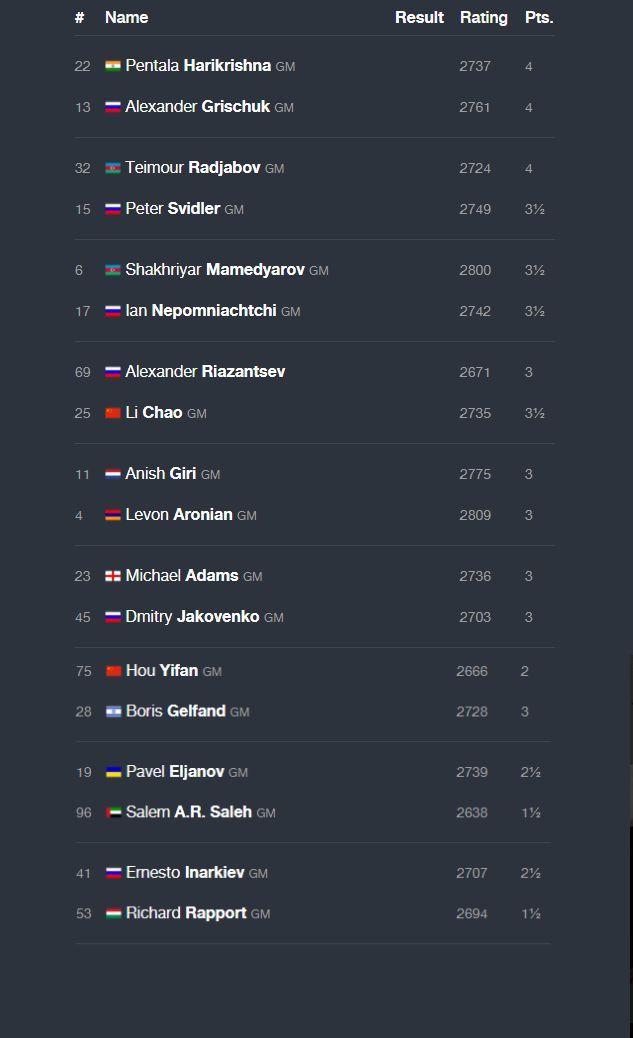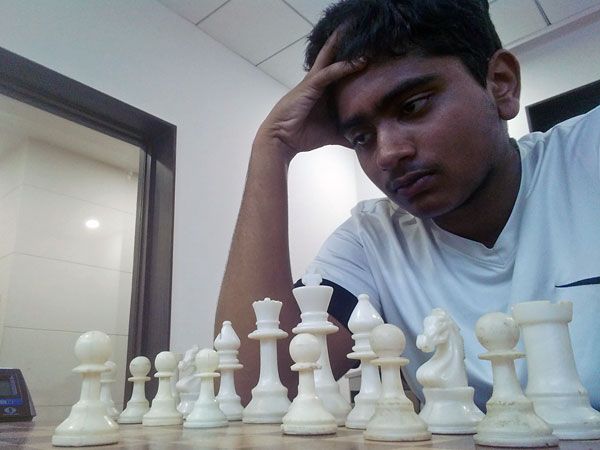Geneva Grand Prix Round 6: Harikrishna stuns Levon Aronian!
Pentala Harikrishna had been chasing the leaders all through the first five rounds of the Geneva Grand Prix. In round six, he was paired against the Armenian superstar, Levon Aronian. Keeping in mind that his opponent was Aronian and that he had the black pieces, it was hard to predict that Hari would emerge victorious and join the top rankers of the leaderboard Radjabov and Grischuk. But the Indian ace did it! A detailed report and game analysis by Tanmay Srinath.
Yesterday was quite an eventful one at the third leg of the Grand Prix series in Geneva. Coming back after a rest day, the players seemed to be full of energy and did their best to capitalise on the smallest of errors of their opponents. Five out of the nine games ended decisively, which is the highest in the tournament so far. India’s Pentala Harikrishna went all guns blazing at his round 6 opponent Levon Aronian. The Gunthur-based Grandmaster had the black pieces against the Armenian megastar who kicked off with an English Opening which went into the lines of the Reversed Sicilian Dragon later. Interestingly, Alexander Grischuk had essayed the same line with the black pieces against Pavel Eljanov and had won the game. But Hari decided not to repeat Grischuk’s preparation and deviated on move 6. Posting his pawns in the centre, Hari played in a very principled manner in the opening phase.

[Site "Geneva"]
[Date "2017.07.12"]
[Round "6"]
[White "Aronian, Levon"]
[Black "Harikrishna, Pentala"]
[Result "0-1"]
[ECO "A29"]
[WhiteElo "2809"]
[BlackElo "2737"]
[Annotator "Tanmay Srinath"]
[PlyCount "76"]
[EventDate "2017.??.??"]
{This 6th Round game pitted the in form Levon Aronian, the latest re-entry
into the 2800 club, and the Indian No.2 Pentala Harikrishna. It was a complex
battle, and both players gave it their all. It produced a decisive result,
that could potentially have a huge impact on the standings.} 1. c4 {Levon is a
stragecially oriented player, and plays closed openings almost all the time.
To see him play c4 is not a surprise.} e5 {1...e5 is the reason many top
players avoid the 1.c4 move order nowadays. Black has a multitude of good
lines at his disposal , such as the Reversed Rossolimo, the Reversed Dragon
etc. Also, since Hari plays e4 as white, this is not a new structure for him.}
2. Nc3 Nf6 3. Nf3 Nc6 4. g3 d5 {The most principled continuation.} (4... Bb4 {
Leads to the reversed Rossolimo, popularised by Karpov and Anand. This is the
line Levon essayed against Nepo as black this year. After} 5. Bg2 O-O 6. O-O e4
7. Ne1 Bxc3 8. bxc3 Re8 9. f3 d5 {Black had an acceptable position, though he
went on to lose later.}) 5. cxd5 Nxd5 6. Bg2 Nb6 {We have now arrived at the
main line of the Reversed Dragon, with some subtle differences, the main one
being the knight's placement on b6.} 7. O-O Be7 8. d3 O-O 9. Be3 Be6 {The
opening phase is almost over, and both sides have developed meaningfully.} 10.
Rc1 {Levon essays a line that has scored heavily in the recent past. By
developing the rook to the half open c-file, white plans to start operations
on the queenside. There are also some lines where the LS bishop is traded for
the knight to weaken black's queenside. Interestingly, Nakamura played the
same line last year against Hari, and went on to lose as well.} (10. a3 {
has been the main move in this position till now. After} a5 11. Rb1 Nd5 12.
Nxd5 Bxd5 13. Qa4 Qc8 {Black has an equal position and went on to win,
Carlsen-Karjakin.}) 10... f5 {A queenside assault is best met by counterplay
in the center or on the kingside. Hari plans a quick and timely f4 or e4 break.
} 11. a3 {An interesting continuation, and a favourite among the top players.}
({When Vishy had white against Hammer in Norway 2014, he had gone for} 11. b4
$5 {The game continued} a6 ({The point is Nxb4 isn't really possible as after}
11... Nxb4 12. Nxe5 $14 {White grabs a center pawn and is better.}) ({The move
} 11... Bxb4 {is even worse. After} 12. Ng5 $1 Bf7 13. Nxf7 Rxf7 14. Qb3 Bxc3
15. Rxc3 f4 16. Bxb6 axb6 17. Bd5 $16 {White is much better.}) 12. a3 Kh8 13.
Na4 Nxa4 14. Qxa4 Bd5 15. Bc5 Bd6 16. Qc2 Qf6 17. e4 $1 $14 {and white
eventually won.}) 11... Kh8 {Hari puts his king out of harm's way, and allows
a possible g5-g4 thrust.} ({It was possible to immediately go} 11... g5 {
and after} 12. d4 f4 13. d5 Nxd5 14. Nxd5 Qxd5 15. Qxd5 Bxd5 16. Bc5 Rae8 $13 {
an unclear position arises, with chances for both sides.}) 12. b4 a6 13. Re1
Qe8 14. Qd2 {Both sides have started carrying out their respective plans, and
now is the time to accurately assess the position as black- whether to further
the kingside assault or play in the center on the half open d-file.} Bd6 $6 {
An unnecessary move. While not a blunder, it worsens the situation.} (14... Rd8
$1 {was called for, with equality after} 15. Qb2 Bf6 16. Bg5 Bxg5 17. Nxg5 Bg8
18. Red1 Qg6 $11) 15. Bxb6 $1 {White now gets an opening, that Levon exploits.}
cxb6 16. d4 exd4 17. Nxd4 Rd8 18. Nxe6 Qxe6 19. Qa2 Qh6 20. f4 $2 {Levon has
played well till this point. He has a good LS bishop, against black's slightly
bad DS bishop, he has real pressure on the queenside, and Black's assault on
the kingside not a reality yet. But now, he falters.} (20. e3 $1 {is the
correct way to blockade the dark squares further. By stopping f4 for now,
white can start thinking about the d-file and the queenside. After} g5 21. Ne2
Be5 22. Red1 Rxd1+ 23. Rxd1 f4 24. exf4 gxf4 25. gxf4 Bxf4 26. Nxf4 Qxf4 27.
Qb2+ Qf6 28. Qxf6+ Rxf6 29. Be4 $16 {White has a tangible edge, and black has
a small mountain to climb in order to save the game.}) 20... a5 $1 {Hari finds
the right move, attacking the b4 square multiple times, and equalises.} 21. b5
$2 {Now, I believe this is the move that lost Levon his point. It is seriously
anti positional, vacating control of c5, and begging the bishop to improve
itself to an already weakened diagonal (drawback of f4).} ({It was time for
damage control with} 21. Red1 {and after} axb4 22. axb4 Bxb4 23. Nd5 Bc5+ 24.
Kh1 Qe6 25. Qb2 Ne7 26. Nxe7 {White manages to hold fort.}) 21... Bc5+ $15 {
The bad dark square bishop transforms into a monster. Black is now better.} 22.
e3 $6 {Another inaccuracy. White is providing targets for black to hit.} (22.
Kh1 {going off the dangerous diagonal, and avoiding potential x-rays and
discoveries, was clearly better. After} Bf2 23. Red1 Bxg3 24. h3 Bxf4 25. bxc6
bxc6 26. Rxd8 Rxd8 27. e3 Bxe3 28. Rd1 Rxd1+ 29. Nxd1 $15 {Black is better,
but only a little.}) 22... Ne5 $1 $17 {A cute move, that takes advantage of
lack of support to e3 to improve the knight to a better square.} 23. Rcd1 $4 {
A blunder in a bad position.} ({Ofcourse not} 23. fxe5 $4 {as after} Bxe3+ 24.
Kh1 Bxc1 25. Nd5 f4 $19 {Black cleans house.}) (23. Nd5 {had to be played,
strengthening e3 and blocking the d-file, though after} Nd3 24. Ra1 Nxe1 25.
Rxe1 Rd6 26. Bf3 Qe6 $19 {Black has all the trumps.}) 23... Ng4 $1 {Now it is
almost over. Hari adds decisive pressure to e3 and h2.} 24. h3 Nxe3 25. Rxd8
Rxd8 26. Kh2 g5 $1 {Forcing more lines open. Hari smells blood, and goes after
it.} 27. fxg5 Qxg5 28. Qe6 f4 $1 {Another strong move. Now, it is all over.}
29. Ne4 Qg7 30. g4 Nc2 31. Rf1 Nd4 $1 {Forces the exchange of queens, after
which black will mop up the a3 pawn and queen his a-file passer.} 32. Qf6 Qxf6
33. Nxf6 Bxa3 34. Bxb7 Bd6 35. h4 a4 36. g5 a3 37. Kh3 Be5 38. Kg4 Nc2 {
And Aronian saw no further use of continuing the game. A great game by
Harikrishna, who now joins the leaders on +2, and greatly increases his
chances of winning this Grand Prix. He took the chances offered today and
clinically demolished one of the world's best players in style. A better
conversion rate with white will go a long way in improving his chances of
qualifying for the Candidates. As for Levon, his chances are almost completely
spoilt, and he now finds himself under pressure to win more than half of his
remaining games to stand a chance.} 0-1



Yifan’s countryman, GM Li Chao, also won his game against the Ukrainian GM Pavel Eljanov. The game opened with a Queen’s Indian Defence in which Eljanov missed a tactical shot in the opening and gave his opponent a significant advantage. Chao kept playing energetically after this and never let his opponent get a chance to come back in the game. By the 35th move, Chao was able to catch Eljanov’s king in a mating net. To avoid mate, Eljanov would have had to give up a piece and still remain in a hopeless position. Cutting short his troubles, the Ukrainian decided to resign at this point.
The round featured two more decisive games. Ian Nepomniachtchi won his game against Ernesto Inarkiev and hopped into the pack of players on the second spot. Alexander Riazantsev got the better of the Hungarian GM Richard Rapport. Rapport – as is characteristic of him – played an irregular opening with the white pieces and came up with some mystical manoeuvres with his heavy pieces. After a few skirmishes in the middlegame, the players reached an endgame where Rapport had to deal with Riazantsev’s far advanced king rook pawn. Although the material on the board was equal, this turned out to be an insurmountable task for Rapport. By the 58th move, the Hungarian was forced to resign as his king was caught in a mating net.

After 6 rounds, three players – Radjabov, Grischuk and Harikrishna – are leading the tournament with 4.0/6. A gnat’s hair away are Mamedyarov, Svidler, Nepomniachtchi and Li Chao with 3.5/6. A six player pack including Giri, Aronian, Adams, Gelfand, Jakovenko and Riazantsev share the third spot with 3.0/6. Eljanov and Inarkiev are fourth with a score of 2.5/6. Hou Yifan is in the second last place with 2.0/6. Richard Rapport and Salim Saleh are at the bottom of the table with 1.5/6.

Replay all the games:
Also on ChessBase India
Geneva Grand Prix Round 5: Grischuk joins Radjabov in the lead; Hari draws Nepomniachtchi
Geneva Grand Prix Round 4: Hari maintains his second spot; holds Radjabov to a draw
Geneva Grand Prix Round 3: Hari misses a big chance against Mamedyarov
Geneva Grand Prix Round 1 & 2: Hari off to a great start!
Coverage on Firstpost
Geneva Grand Prix, Round 5: P Harikrishna draws vs Ian Nepomniachtchi; Alexander Grischuk joint top
Geneva Grand Prix, Round 4: P Harikrishna stays second after 20-move draw against Teimur Radjabov
Geneva FIDE Grand Prix: P Harikrishna beats Alexander Riazantsev after 84-move grind in round one
